Goldendoodles, beloved for their friendly demeanor and adorable appearance, come in various colors that add to their charm. These playful dogs’ colors reflect the diverse combinations of their Golden Retriever and Poodle parentage, from rare and unique hues to more commonly seen shades.
These hybrid dogs are a cross between the friendly and intelligent Golden Retriever and the hypoallergenic and highly trainable Poodle. Combining the best traits of both parent breeds, these dogs are known for their loving and affectionate nature, intelligence, and versatility. Goldendoodles have become a popular choice for families and individuals alike with their non-shedding coats and joyful temperament. Whether it’s their playful energy, gentle disposition, or their ability to be excellent therapists or service dogs, doodles continue to amaze and bring joy to countless households. If you want more information on Goldendoodles as service dogs click here.
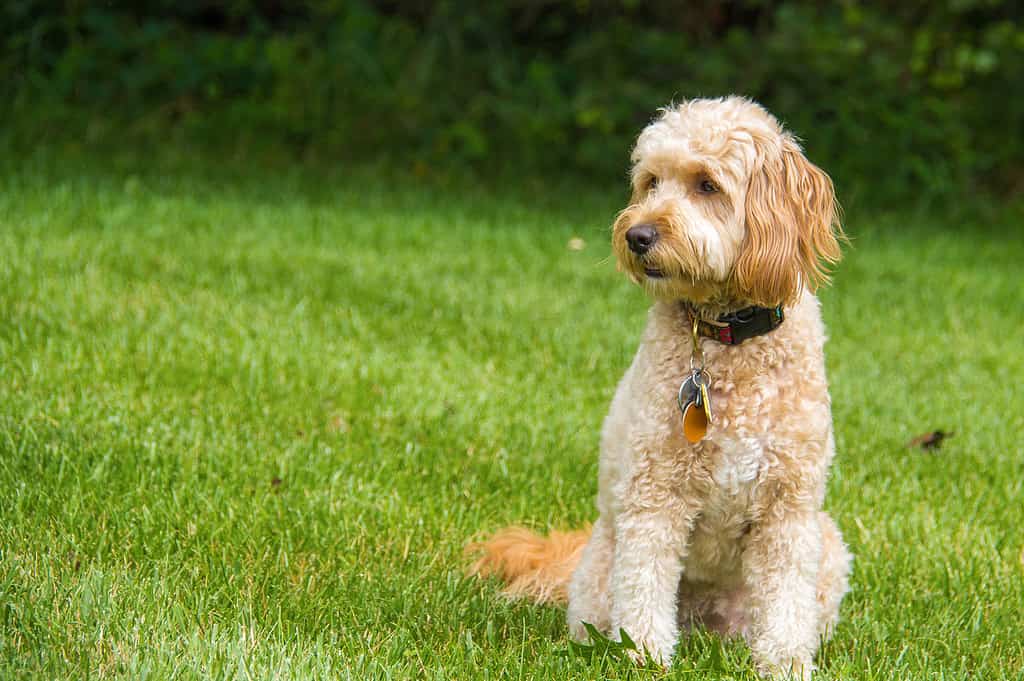
These hybrid dogs are a cross between the friendly and intelligent Golden Retriever and the hypoallergenic and highly trainable Poodle.
©iStock.com/Marcello Sgarlato
There are many colors, and choosing your favorite is hard. Popular colors include black, apricot, and brown. You can also find rare colors, including black and white, brindle, gray, and sable. This article will explore the spectrum of Goldendoodle colors, from the rarest to the most common, shedding light on their characteristics and appeal.
Merle
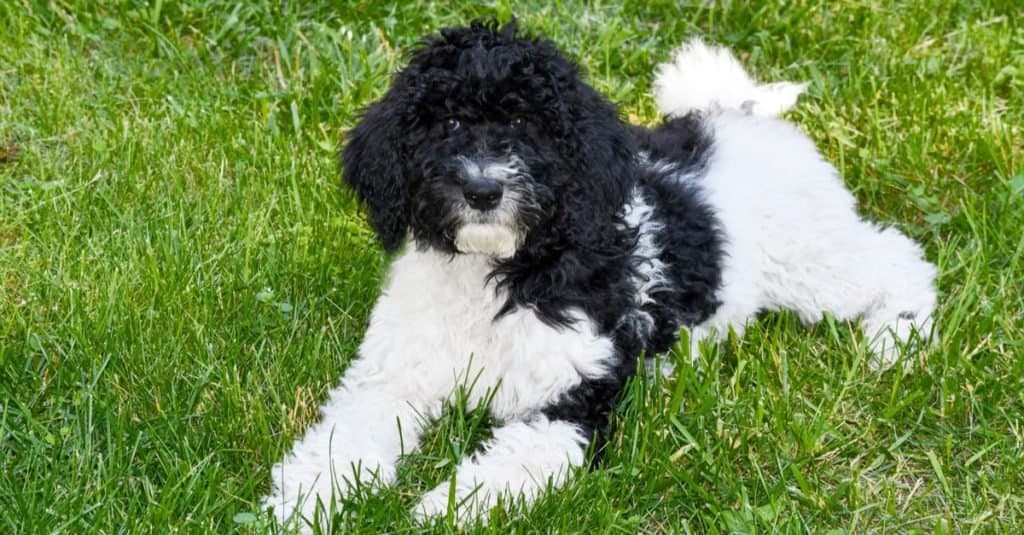
This unique coloration arises from the Merle gene, which creates irregular patches of different colors.
©Guy Banville/Shutterstock.com
The Merle is the rarest shade out there. The Merle captivates with its stunning look of mottles or marble coat patterns. This unique coloration arises from the Merle gene, which creates irregular patches of different colors, often including gray, black, and white variations. The color pattern is rare because the merle is a dominant gene not present in golden retrievers. The Merle gene formulates by crossing a Merle poodle with a golden retriever, rendering the genetic pool smaller than most other dogs.
Parti
Parti boasts a predominantly white coat adorned with patches of solid colors, often in shades of brown, black, or even red. This mixed dog breed consists of a distinctive bi-color coat composed of white and a secondary color. Producing doodles with this coat pattern is very difficult as it requires multigenerational breeding, so it’s no surprise these colors are rare.
Phantom
Phantoms exhibit a striking color pattern characterized by a solid base coat and distinct markings on specific areas such as the face, paws, and tail. The markings are usually a different color from the base coat. The most common combination is a black base coat with tan and apricot markings. The Phantom consists of two colors in specific locations. The coat pattern consists of a primary color with markings of a secondary color located on the eyebrows, muzzle, chest, lower legs, and sometimes under the tail or inside the ears.
Sable
Sable boasts a color coat that transitions from a solid base color to darker tips, creating a shaded and shimmering appearance. Ranging from light to dark shades, sable coats add depth and character to the dogs. A sable has a coat that features black-tipped hairs with roots of any solid color. These black-tipped hairs can be in any location or pattern across the coat. This coloring refers to as being like “burnt toast.” The term “sable” describes the black tips of the dog’s coat. The rest of the fur can be a wide range of colors, such as chocolate, cream, apricot, gray, silver, white, black, fawn, or red.
Chocolate
The most striking feature of the chocolate is its unique coat which is soft, curly, and chocolate brown, hence the name. Their coats are also low-shedding, making them an excellent choice for people with allergies or who prefer a cleaner home.
Black
Black doodles are rare, and there is an increased chance of getting a black doodle if they breed as the second or third generation. If a black Goldendoodle parent is crossed with a poodle, the offspring will nearly always be black. The black doodle coat feels soft and has no shedding. Depending on the coat type, Black doodles can be as close to hypoallergenic as possible. They can also come in any size.
Red
A red dog’s rich and deep red coat exudes warmth and charm. This vibrant hue is trendy among owners and admirers due to its captivating appearance and the radiant aura they bring to any setting. Red doodles are also not rare. Red is a dominant Poodle gene, so if a Golden Retriever is bred with a Red Poodle, it is likely that many of the puppies in the litter will inherit this coat color.
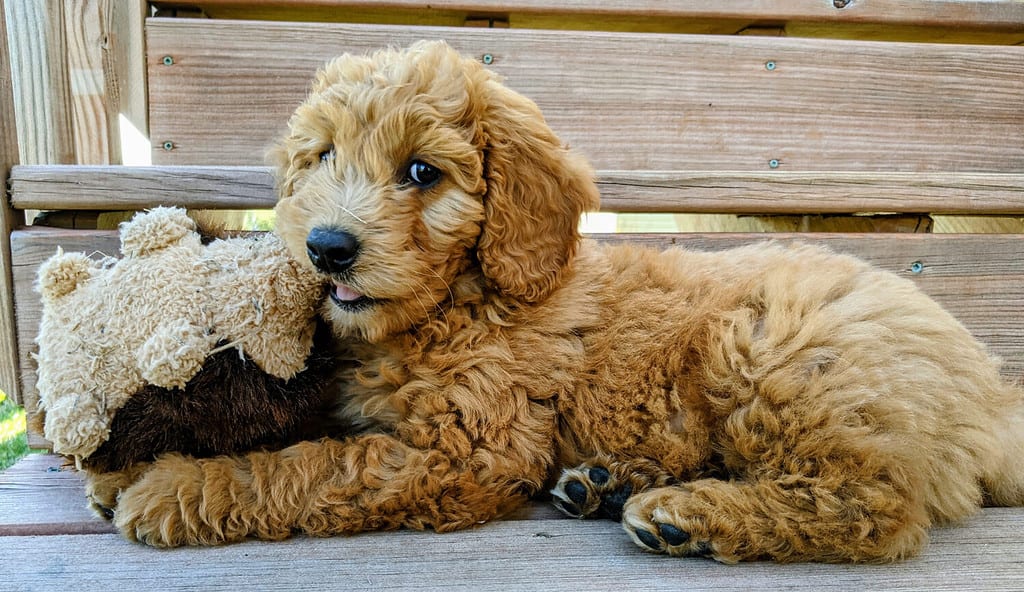
Goldendoodles are not hypoallergenic and often shed pretty heavily. They also require constant maintenance when it comes to grooming.
©DBjorgo/Shutterstock.com
Apricot
An Apricot Goldendoodle is similar to the inside of a peach. The most common misconception about Apricot Goldendoodles is that they’re the same as Red Goldendoodles. A Red Goldendoodle is much darker and similar to an Irish setter.
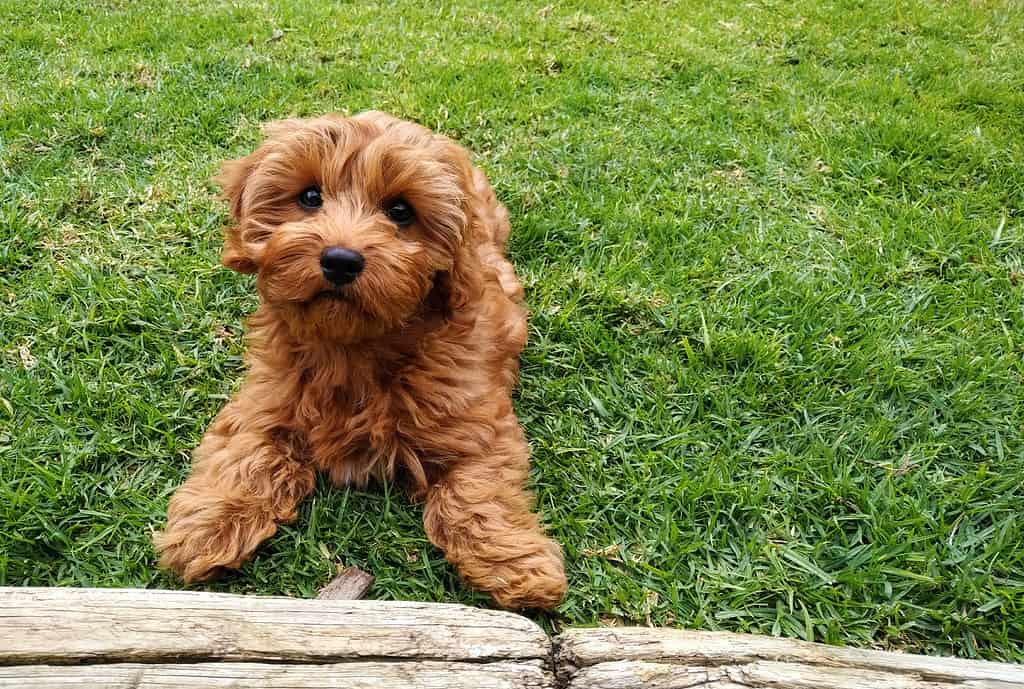
Petite Goldendoodle playing outside.
©Making Connections/ via Getty Images
Cream
English Cream Goldendoodles are known for their sturdy body type and more blocky heads. These attributes give English Cream Goldendoodles the nickname of Teddy Bear Goldendoodles. English Cream Goldendoodles are well known for their gentle disposition Teddy Bear look, and gorgeous, lighter coats.

English Cream Goldendoodles have the nickname the “Teddy Bear” of Goldendoodles.
©Rena Schild/Shutterstock.com
Many Goldendoodle breeders use the term “English Cream” to refer to any Goldendoodles that are lighter colored than usual. American Goldendoodles differ from English Cream Goldendoodles mostly in looks and not temperament. American or regular Goldendoodles have a much larger variety of colors and sizes. Goldendoodles have a much larger variety of colors and sizes. They are not restricted to the lighter end of the color spectrum as English Goldendoodles and can range from white to black.
Gold
Gold Goldendoodles are the most common and frequently seen in the Goldendoodle breed. The color yellow is associated with honey and yellow.
How Do Coat Genetics Work?
Goldendoodle coat genetics can initially seem complex, but when it comes to coat colors, Goldendoodles follow specific genetic patterns that determine the hues they will inherit. Here’s a closer look at how these genetics work:
Chocolate and Black Base Colors
In the case of chocolate or black Goldendoodles, the coat color is primarily influenced by the presence or absence of specific genes. A chocolate or black Goldendoodle, without any additional genetic factors, will result in puppies of the same color as the parent.
Dominant and Recessive Genes
If a Goldendoodle possesses a dominant black gene alongside a recessive chocolate gene, having just one copy of the dominant black gene will lead to a black coat. However, the puppy must inherit two chocolate genes for a chocolate coat.
Chocolate Goldendoodles
To produce a chocolate Goldendoodle puppy, both parents must carry a chocolate gene. Since golden retrievers rarely have chocolate genes, breeders typically use an F1B generation dog or higher to achieve a chocolate Goldendoodle.
Determining the Base Coat
Regardless of the final coat color, every Goldendoodle has a base coat that is either chocolate or black. To discern the base coat, look at the dog’s nose. The base coat is chocolate if the nose is brown, while a black nose indicates a black base color.
Predicting the exact coat color of a Goldendoodle puppy is nearly impossible without a DNA test of both parents. DNA testing can provide valuable information about the alleles carried by the dog and determine whether the genes are dominant or recessive.
Dominant and Recessive Alleles
Alleles come in pairs and play a significant role in coat color inheritance. The letter “B” represents a dominant black allele, while “b” represents a recessive black allele. Interestingly, a combination of dominant and recessive alleles can result in brown puppies, even when both parents are black.
Will My Goldendoodle Change Color?
As Goldendoodles transition into adulthood, certain parts of their coat retain more of their puppy color while others change. For instance, the fur around the ears and muzzle tends to hold onto their original hues, creating a delightful contrast. Breeders use the term “holding” to describe this phenomenon when a Goldendoodle retains its coat color until maturity.
However, it’s essential to understand that Goldendoodle puppy coats often undergo a natural process known as “clearing.” During this phase, the coat may fade, become dull, or even lighten to a different color altogether. To account for these changes, you should choose a slightly darker coat color puppy than your desired preference. Doing so makes the color more likely to fade to a lighter version as the clearing process unfolds.
Frequently Asked Questions
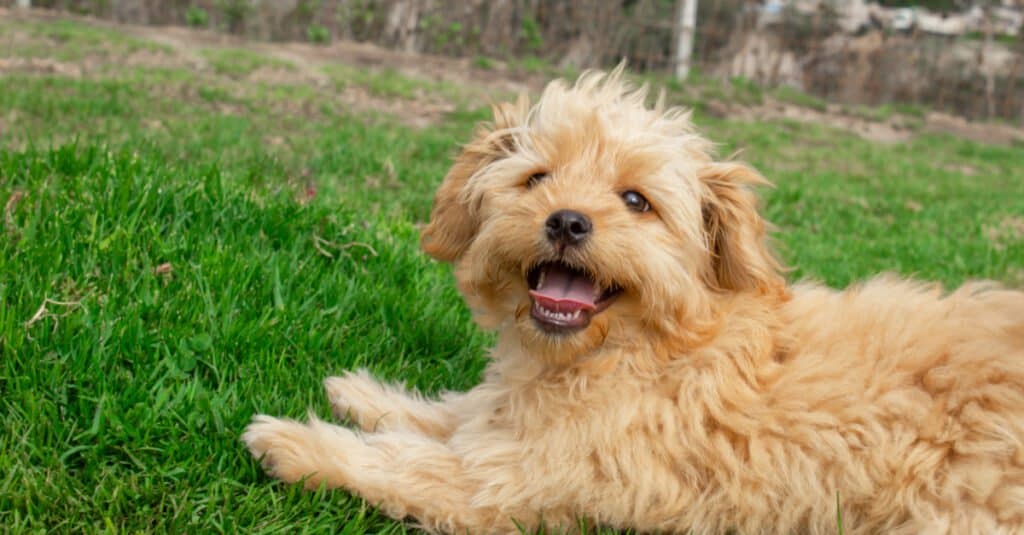
As Goldendoodles transition into adulthood, certain parts of their coat retain more of their puppy color while others change.
©Anasty/Shutterstock.com
What is The Most Popular Goldendoodle Color?
Among the array of Goldendoodle colors, the most popular choice tends to be apricot, followed closely by lighter shades of cream and vibrant red. Golden hues also enjoy a significant level of popularity.
What Is The Rarest Goldendoodle Color?
The rarest Goldendoodle colors are gray, blue, and silver, achieved through painstaking multigenerational breeding efforts. These unique shades are seldom seen, and dogs beyond the second generation are often purposefully bred to produce these striking colors.
Goldendoodle Personality
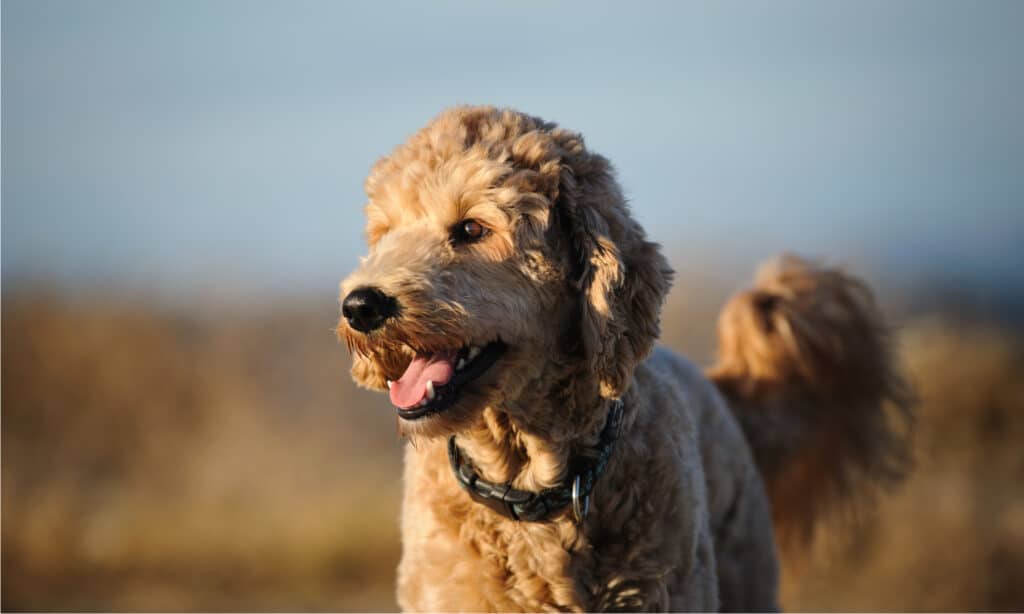
Goldendoodles generally possess a pleasant demeanor and get along well with everyone they meet.
©everydoghasastory/Shutterstock.com
Goldendoodles are renowned for their cheerful and outgoing nature, always aiming to please their human companions. It’s important to note that a dog’s personality can vary based on genetic factors and the level of socialization they receive. However, Goldendoodles generally possess a pleasant demeanor and get along well with everyone they meet.
Their inherent “everyone-is-my-friend” personality has earned Goldendoodles a stellar reputation as fantastic family dogs. They exude happiness, are playful by nature, and possess the patience and stamina required to engage in spirited activities with children. As with any dog, proper socialization and positive reinforcement training are essential to ensure that Goldendoodles and children maintain safe and amicable interactions.
By fostering an environment of socialization and providing upbeat guidance, you can help nurture and enhance the friendly and gentle nature that Goldendoodles are known for. They will undoubtedly thrive as loving companions, bringing joy, laughter, and endless playfulness to your family dynamic.
Ideal Environment for a Goldendoodle
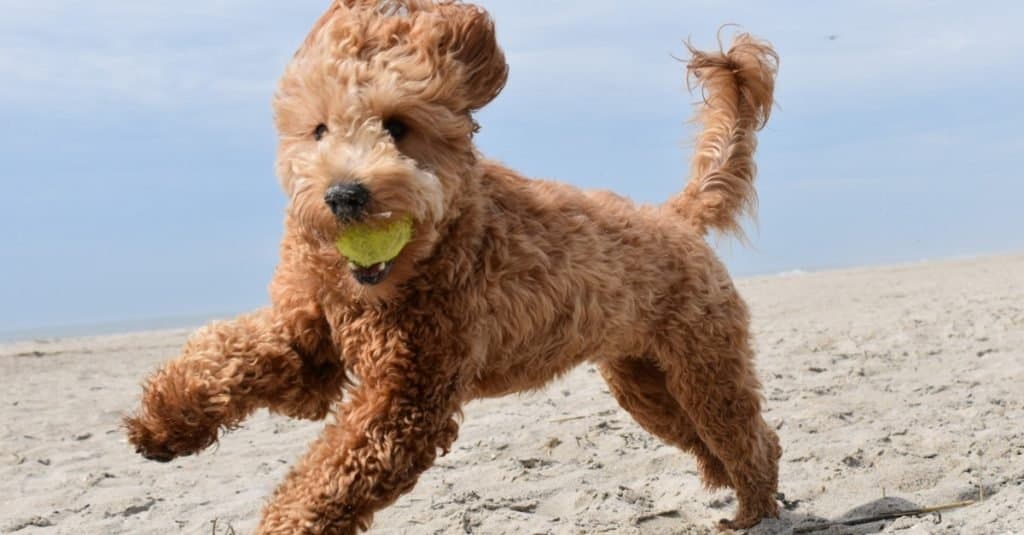
Goldendoodles will flourish with daily exercise and ample time with their loved ones.
©W.H. Photography/Shutterstock.com
Goldendoodles thrive in an environment where they can be close to their beloved humans, thanks to their moderate energy levels and affectionate nature. Whether you reside in an apartment or a house with a spacious yard, your Goldendoodle will flourish with daily exercise and ample time with their loved ones. Regular long walks are essential to meet their exercise needs.
Given their retriever heritage, many Goldendoodles enjoy engaging in a lively game of fetch. Having a fenced yard can be a tremendous advantage in facilitating this activity. However, it’s worth noting that Goldendoodles can adapt to apartment living as long as they have access to outdoor activities such as walks, runs, hikes, and even the occasional swim (although not all Goldendoodles are fond of water).
Being a social breed, Goldendoodles thrive when they are in the company of their family and friends indoors. While they require outdoor playtime, it’s important not to leave them outside for extended periods. Ensure they have a comfortable and cozy resting place inside your home and easy access to ample fresh water throughout the day.
By providing a loving and stimulating home environment that includes regular exercise, indoor companionship, and appropriate rest, you can create the ideal setting for your Goldendoodle to lead a happy, healthy, and fulfilling life as an integral part of your family.
The photo featured at the top of this post is © SoySendra/Shutterstock.com
Thank you for reading! Have some feedback for us? Contact the AZ Animals editorial team.







